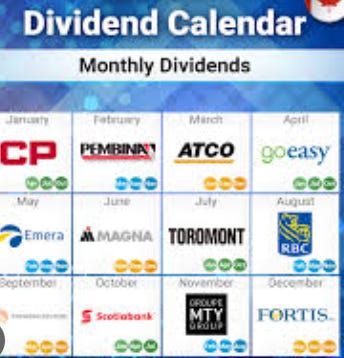Why Do You Always Feel Overwhelmed by Your Financial Life?
If your financial life leaves you feeling overwhelmed and afraid, you’re not alone.
source: created by author in Bing Image Creator
Living and practicing at the intersection of a retired clinical psychologist and financial advisor, I’ve long inhabited a unique perch; I’ve observed the behavioral effects exerted by the economy and stock market visited upon investors and savers. Some are tolerated well. Others, not so much.
Forty-something years before the term was coined and the field of behavioral economics was born, I’ve been on the front line, formulating and postulating many connections that bind investors to one another and define their interactions with each other, both in the economy and the workings of the shareholder economy, otherwise known as the stock and bond markets.
The first 10 annual paid subscribers this week will receive the RODAT Portfolio Income Tracker ($99.99 retail value) which will reveal every RODAT stock in our subscriber portfolio, share counts and dividend amounts. With this digital tool, you may track the portfolio and mirror your own portfolio with the names you find suitable for your needs.
In addition, be among the first 10 annual paid subscribers this week and receive the digital Stock Market Investing Tool of your choice ($99.99 retail value), many of which are in real time and will greatly enhance your potential for capital gain and dividend income.
Make your complimentary choice here.
Panic Mode
A great majority of investors go into panic mode when they check the markets and their brokerage statements too often. This occurs due to the short attention span and near-term focus these folks have on their money and investments.
A steady march upwards in inflation data points exerts similar feelings of fear. Overwhelmed by price increases that outpace salary increases, consumers feel overwhelmed and experience anxiety over paying the weekly bills. The uncertainty of being able to put food on the table becomes a paramount concern. And no wonder. Food insecurity is amongst the worst fears a consumer and her children can ever experience.
Source: created by author in Bing
The recent squeeze in housing and the concomitant rise in prices has crimped most consumers’ idea of the American Dream; that house with a white picket fence seems farther and farther off in the distance. A shortage of housing and upward creep in mortgage interest rates is responsible for the price of housing’s recent price rise, up to 37% in some areas, in one year alone.
This is the stuff of consumer nightmares and is being experienced by large and growing cohorts in the nation and around the world.
At the same time, all of these things fall into the category of things that you cannot control. That is why it is more comforting and productive to focus on those areas that are, indeed, well within your control.
Once you do this, perceived feelings of anxiety and distress can reduce to the point that you begin to observe you actually have control of more of the things that matter in your life.
Take Control Back With These 9 Tasks
Here are 9 tasks you can complete during your mid-morning work break or lunch break ; not all at once, of course.
1. Check your credit reports
By law, the three major credit bureaus — Equifax, Experian and TransUnion — must give you a free copy of your file every 12 months. At the onset of the pandemic, the bureaus made it even easier for consumers to view their credit history by offering free weekly credit reports. Although the offer was supposed to sunset last year, the bureaus permanently extended it. Go to the official site where you can get your reports free — annualcreditreport.com — and make sure there isn’t something in your file that shouldn’t be there.
2. Freeze your credit
If you’re worried about your information being compromised by data breaches, freeze your credit. This prevents swindlers from accessing your credit report without your permission, making it harder for them to take out loans or open new credit cards in your name. Just note that you need to request a credit freeze, which is also called a security freeze, at each of the three bureaus. I did this recently with one of my credit cards when a reported expenditure was suspicious. It was very easy to do, and also simple to undo once my situation was sorted out.
3. Calculate your net worth
How rich are you? You probably don’t think you’re prosperous. So let me ask this question another way: Do you know how much you’re worth? We keep score of so many things. Many people have never calculated their personal net worth. Instead, they measure their financial success by how much they earn each year. However, a net worth statement gives you a clearer and bigger-picture view of your financial health. List your assets — money in bank accounts, the market value of your home and car, and the value of your investments. Then, list all your liabilities — mortgage, auto loan, credit card balances, student loans and outstanding tax debt. Subtract your liabilities from your assets to determine your personal net worth.
Scroll down the page at Nerdwallet to use their simple net worth calculator and get a quick handle on this aspect of your financial life.
Once you get a handle on your net worth, you just might feel much more in control of your financial situation than you ever thought was possible.
4. Set up a 529 college savings plan
My twin boys graduated from college debt-free in large part because of the savings in their 529 plans. A 529 plan is a designated college savings plan. Earnings are not taxed if used for qualified education expenses like tuition or books. Use the College Savings Plans Network’s 529 Comparison Tool to compare plans. Another good source is savingforcollege.com. The tax savings alone, granted by the IRS and your State revenue agency, are well worth establishing these plans. And the earnings in these plans, if started early and left alone for 18 years before they start college bestow all the benefits of compounding your investment in these plans.
5. Learn more about your 401(k) plan
Do you know how your retirement plan contributions are invested? If not, spend some time reviewing the retirement choices in your workplace plan, the fees you’re being charged and your investment performance. Double-check your retirement contributions. For best performance, choose mutual funds with miniscule fees that track the S&P 500 Index. Here’s a question I ask often but people often don’t know: What percentage of your pay are you saving for retirement in your workplace plan?
The number of 401(k) millionaires hit a record in the second quarter, according to Fidelity Investments, one of the largest administrators of workplace retirement plans. One of the habits that helped many get into the millionaire’s club is saving at least 15 percent of their annual pretax income for retirement. The 15 percent target, recommended by Fidelity, includes a combination of what you’re putting in and the matching contribution you might be receiving from your employer.
6. Sign up online to view your Social Security statement
Regularly reviewing your Social Security statement should be a key part of your retirement planning. To set up an account, go to ssa.gov and look for the sign-in link for “my Social Security account.” In 2021, the Social Security statement got a much-needed makeover. The redesign includes a chart that can help you decide when to collect your benefit. If you can delay claiming, a year-by-year benefit amount illustration is a great reminder of why waiting may be worth it.
Every year you delay beyond your full retirement age, up to age 70, you get an increase in your benefit. The percentage increase varies depending on when you were born. If you were born in 1943 or later, your benefit increases by 8 percent for each full year you delay receiving Social Security beyond your full retirement age. (Full retirement now falls between 66 and 67, depending on your birth year.)
Just note that if you’ve placed a security freeze, fraud alert or both on your credit report, you will not be able to open the account until you remove the freeze first, because Social Security uses information in your credit file to verify your identity. Once you establish the account, you can freeze your credit report again.
7. Create an IRS online account
Setting up an IRS online account is one way to keep an eye out for suspicious activity related to your federal tax return. Here’s a direct link: irs.gov/your-account. In the box that says “Individual,” you’ll find the link to establish an online account. On that page, click the link that says: “Sign into your online account.”
8. Cancel unnecessary services
If you’re having trouble finding money to build upon or even start an emergency fund, take an assessment of all the services, streaming, that Starbucks morning coffee and otherwise, that you could do without. Then, cancel the ones you really don’t use much.
9. Identify and prioritize your financial goals
List the things you hope to accomplish with your money. I find writing down my financial priorities helps me stay on track with budgeting and saving. And don’t edit out the fun things you want to do. It’s O.K. to live a little.
Your Takeaway
If you find yourself feeling overwhelmed by inflation, rising prices of houses or roller coaster rides in the stock market, don’t fret. Do something about it! Take control over the things in your life that you can control. Once you get into this habit, slowly but surely, you’ll begin to learn how to de-stress. Condition yourself with the positive reinforcement you can achieve from the suggested activities we’ve discussed here.
Tamping down financial anxieties is possible, but only if you want to.
We have many stocks with strong buy recommendations that you can learn about by upgrading your subscription to Paid today so you can take full advantage of our comprehensive service.
My Real Time Portfolio Trackers and stock market investment applications to enhance your investing returns and income are available here.
Stock Market Investing Applications
To date, subscribers to my investment newsletter, “Retirement: One Dividend at a Time” who faithfully mirrored our portfolio have attained annual dividend income over $132,000.00.
You are welcome to a free, two-week trial to my investment newsletter, “Retirement: One Dividend at a Time”. Just shoot me an email and request your free trial, at geoschneider1@gmail.com
To receive notice whenever I publish new articles, simply click the follow button at the top of the article next to my name. Better yet, also click the “Subscribe” button and you’ll receive an email notifying you whenever I publish. Thank you.
So glad you can join me here today. Please consider becoming a paid subscriber of my Substack community for the full experience and so we can do even more.
The first 10 annual paid subscribers this week will receive the RODAT Portfolio Income Tracker ($99.99 retail value) which will reveal every RODAT stock in our subscriber portfolio, share counts and dividend amounts. With this digital tool, you may track the portfolio and mirror your own portfolio with the names you find suitable for your needs.
In addition, the first 10 annual paid subscribers this week will receive the digital Stock Market Investing Tool of your choice ($99.99 retail value), many of which are in real time and will greatly enhance your potential for capital gain and dividend income.
Make your complimentary choice here.
For just $5 per month, or $50 annually, you’ll receive full access to every article I write, complete access to my entire archive of articles, access to a special chat group of similarly minded investors and deep-dive articles for paid subscribers only, with recommended dividend growth stocks to supplement your Social Security benefit.
If you found value in this article and would like to support my efforts, please consider buying me a coffee, here.
buymeacoffee.com/georgeschneider
Discover my archive of articles on Substack, here.
Other articles you may find valuable reading:
Investing in Realty Income: A Smart Choice for Monthly Dividends
Is September the Most Bearish Month? That Depends
What If No One Ever Sold Even One Share of Stock?
Most Recipients Aren’t Interested in Waiting to Claim Social Security Benefits
Best,
George Schneider, M.A.
Founder and publisher
Retirement: One Dividend At A Time
Disclaimer: This article is intended to provide information to interested parties. As I have no knowledge of individual investor circumstances, goals, and/or portfolio concentration or diversification, readers are expected to complete their own due diligence before purchasing any stocks mentioned or recommended.
Disclosure: I am long all RODAT Portfolio names. The Portfolio continues to build dividend income with reliable, dependable equities which have long histories of increasing the dividend.
Copyright ©2024, George Schneider











